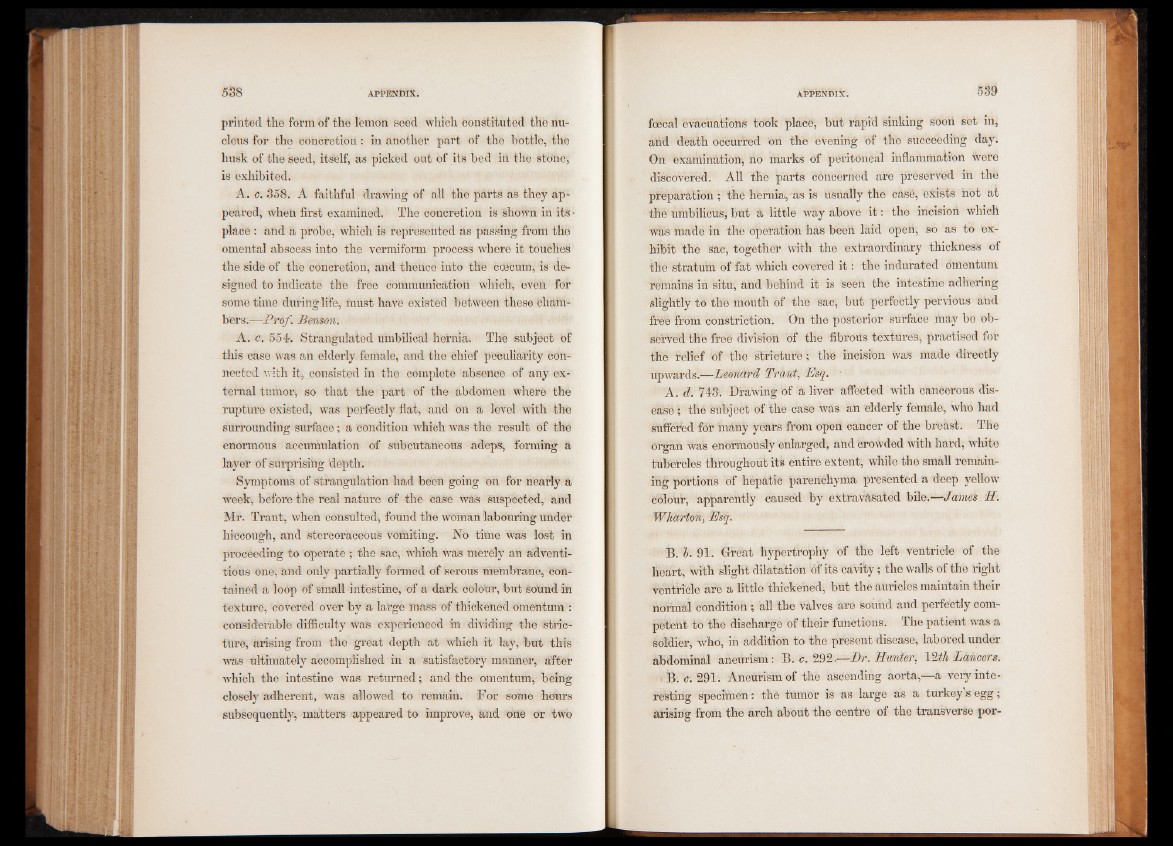
printed the form of the lemon seed which constituted the nucleus
for the concretion: in another part of the bottle, the
husk of the seed, itself, as picked out of its bed in the stone,
is exhibited.
A. c. 358. A faithful drawing of all the parts as they appeared,
when first examined. The concretion is shown in its *
place : and a probe, which is represented as passing from the
omental abscess into the vermiform process where it touches
the side of the concretion, and thence into thO eoOcum, is designed
to indicate the free communication which, even for
some time during life, must have existed between these chambers.—
Prof. Benson.
A. c. 554. Strangulated umbilical hernia. The subject of
this case was an elderly female, and the chief peculiarity connected
with it, consisted in the complete absence of any external
tumor, so that the part of the abdomen where the
rupture existed, was perfectly flat, and on a level with the
surrounding surface; a condition which was the result of the
enormous accumulation of subcutaneous adepS, forming a
layer of surprising ‘depth.
Symptoms of strangulation had been going on for nearly a
week, before the real nature of the case was suspected, and
Mr. Trant, when consulted-, found the woman 'labouring under
hiccough, and stercoraceous vomiting. No time was lost in
proceeding to operate ; the sac, which was merely an adventitious
one, and only partially formed of serous membrane, contained
a loop of small intestine, of a dark Colour, but sound in
texture, covered over by a large 'mass of thickened omentum :
considerable difficulty was experienced in dividing the stricture,
arising from the great depth at which it lay, but this
was ultimately accomplished in a satisfactory manner, after
which the intestine was returned; and the omentum, being
closely adherent, was allowed to remain. For some hours
subsequently, matters appeared to improve, and one or two
foecal évacuations took placé, but rapid sinking soon set in,
and death Occurred on the evening óf the succeeding day.
On examination, no marks of péritonéal inflammation were
discovered. All the parts concerned are preserved in the
preparation; the hernia,'as is usually thé casé, exists not at
the umbilicus; but a little way above it : the incision which
was madé in the operation has been laid open, so as to exhibit
the sac, together with the extraordinary thickness of
the stratum of fat which covëred it : the indurated omentum
remains in situ, and behind it is seen the intestine adhering
slightly té thé mouth of the Säe, but perfectly pervious and
free from constriction. On the posterior surface may be observed
the freé division of the fibrous textUreS; practised for
the relief of the stricture ; the incision was made directly
upwards.—Leonard Trant, Esq.
A. d. 743. Drawing Of a liver affected with cancerous disease
; thé subject Of the case was an elderly female, who had
sufierted for many years from open cancer of the breast. The
organ was enormously enlarged, ahd Crowded with hard, white
tubercles throughout its entire extent, while the small remaining
portions of hèpàtic parenchyma presented a deep yellow
colour, apparently caused by extravàSated bile.—James H.
Wharton, Esq.
B. h. .91. Grreat hypertrophy of the left ventricle of the
heart, with slight dilatation Of its cavity ; the walls of the right
Ventricle are a little thickened^ but the auricles maintain their
normal condition ; all the valves are Sound and perfectly competent
to the discharge of their functions. The patient was a
Soldier, who, in addition to the present disease, labored under
abdominal aneurism: B. c. 292.—.Dr. Hunter, IZth Lancers.
B. c. 291. Aneurism of the ascending aorta,—a very interesting
specimen : the tumor is as large as a turkey s egg ;
arising from the arch about the centre of the transverse por